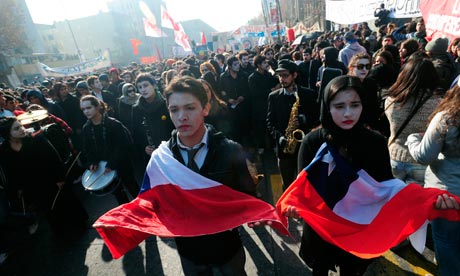 |
| Chilean students march in the streets of Santiago |
From People's Voice newspaper
The past year and a half has seen significant student resistance in the streets in Britain and Ireland, across Europe and the US, as well as North Africa and the Middle East. But one of the most significant struggles over education is in Chile, against the right‑wing government of billionaire president Sebastian Pinera.
Most basic and secondary schools, and most universities in Chile have been privatised. Even public universities charge large fees. The state dedicates less than 5% of Chile's GDP to education, leaving students and families to pay 75% of education costs.
Not surprisingly, debts affect 70% of all university students, and most from poor families drop out. Monthly fees range from $240 to $840 CND; the average monthly salary in Chile is a little over $1,000.
Protests started in July 2011, when miners shut down state-owned Codelco copper mines to protest privatization and demand higher pay and benefits in light of record global copper prices. The miners walked out on the 40th anniversary of the Salvador Allende government's nationalization of Chile's mining sector, joined by 7,000 students and teachers.
"We believe that the key to a successful student movement is [...] to interweave social networks with the people, the workers, with social organizations, the trade unions, and with the youth who did not make it into the University ‑ who were left kicking stones," said student leader Camila Vallejo, who is also a member of the Central Committee of the Young Communists of Chile.
In August, a political strike was launched on the national level by labour, calling to replace the Pinochet‑era constitution with a new charter guaranteeing free quality education. Repeated mobilizations saw 82 unions walk out. Santiago ground to a halt with 100,000 in the streets.
"The truth is I do not know the difference between the political and social, when social organisations realise that the current institutional framework cannot resolve the big issues of our country, such as the subject of education," Communist Party president and MP Guillermo Teillier said.
A few days later, 600,000 marchers turned out in a country of about 15 million.
Into the fall and winter, students held negotiations with the government, as well as hunger strikes, occupations, disruptions of the Senate, and many more peaceful demonstrations, often facing police water cannons, tear gas, beatings and hundreds of arrests. Neo‑fascists also burnt the offices of the Communist Party of Chile. A government official tweeted about Vallejo: "Kill the bitch and the pack falls apart."
The demonstrations have taken place on a backdrop of indigenous land reclamations, environmental protests against damming of Patagonian rivers, and protests by gay and lesbian activists, earthquake victims, and the homeless and the poor against high gas prices. "This is no movement that comes of spontaneity," Vallejo told Chilean newspaper Voz. "It's been developing over many years based on historical demands of the Chilean student movement."
"Not since the days of Zapatistas' Subcomandante Marcos has Latin America been so charmed by a rebel leader," UK newspaper The Guardian has written. Vallejo is currently Vice‑president after another leftist (united with right‑wingers) defeated her in the student federation's presidential vote. In January it was announced she was releasing a book of interviews and may be the Communist Party's candidate in Chile's Presidential elections.
"We do not want to improve the actual system, we want a profound change ‑ to stop seeing education as a consumer good, to see education as a right where the state provides a guarantee," Vallejo says. Student actions are now building in Argentina and Colombia.









No comments:
Post a Comment